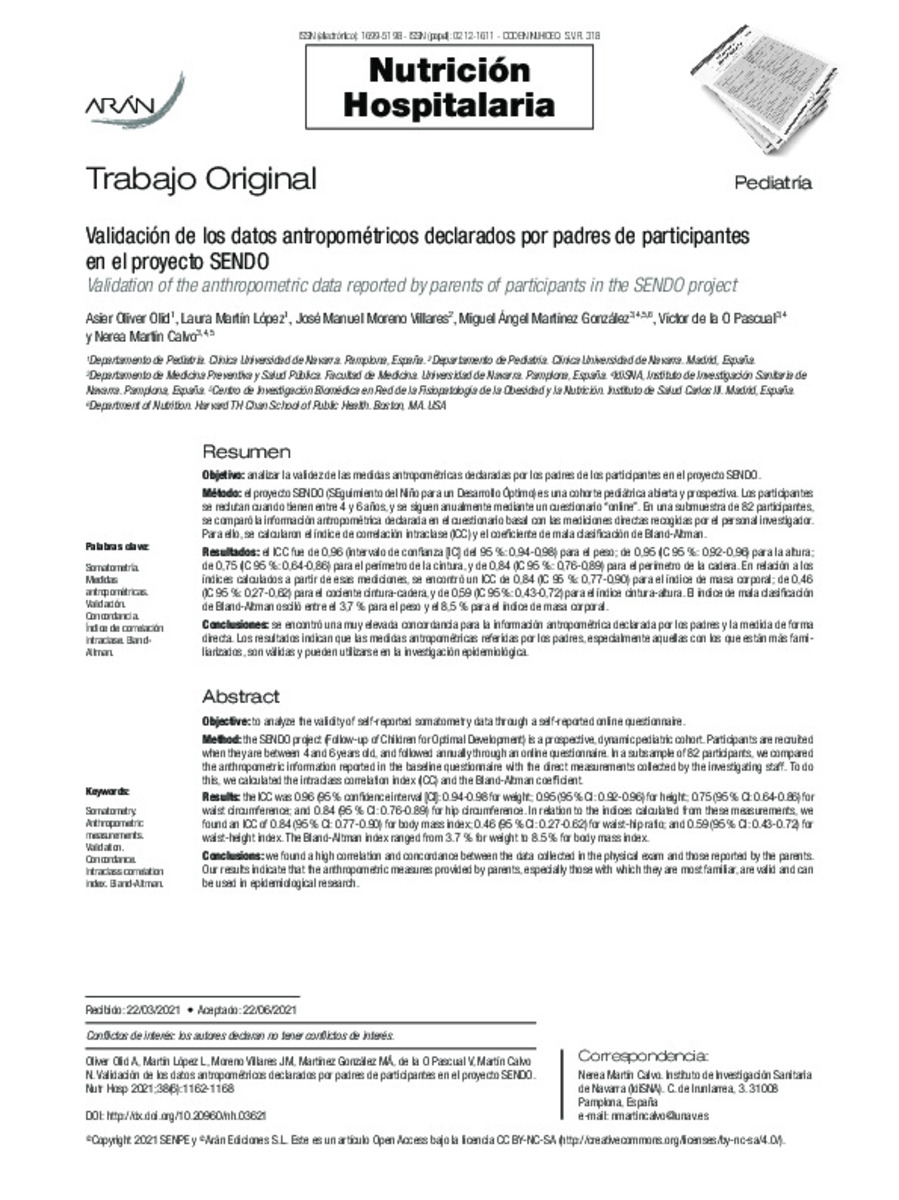Full metadata record
| DC Field | Value | Language |
|---|---|---|
| dc.creator | Oliver, A. (Asier) | - |
| dc.creator | Martin-López, L. (Laura) | - |
| dc.creator | Moreno-Villares, J.M. (José Manuel) | - |
| dc.creator | Martinez-Gonzalez, M.A. (Miguel Ángel) | - |
| dc.creator | De-la-O-Pascual, V. (Víctor) | - |
| dc.creator | Martin-Calvo, N. (Nerea) | - |
| dc.date.accessioned | 2024-02-20T09:10:23Z | - |
| dc.date.available | 2024-02-20T09:10:23Z | - |
| dc.date.issued | 2022 | - |
| dc.identifier.citation | Oliver, A. (Asier); Martin-López, L. (Laura); Moreno-Villares, J.M. (José Manuel); et al. "Validación de los datos antropométricos declarados por padres de participantes en el proyecto SENDO". Nutrición Hospitalaria. 38 (6), 2022, 1162 - 1168 | es |
| dc.identifier.issn | 1699-5198 | - |
| dc.identifier.uri | https://hdl.handle.net/10171/69128 | - |
| dc.description.abstract | Objetivo: analizar la validez de las medidas antropométricas declaradas por los padres de los participantes en el proyecto SENDO. Método: el proyecto SENDO (SEguimiento del Niño para un Desarrollo Óptimo) es una cohorte pediátrica abierta y prospectiva. Los participantes se reclutan cuando tienen entre 4 y 6 años, y se siguen anualmente mediante un cuestionario “online”. En una submuestra de 82 participantes, se comparó la información antropométrica declarada en el cuestionario basal con las mediciones directas recogidas por el personal investigador. Para ello, se calcularon el índice de correlación intraclase (ICC) y el coeficiente de mala clasificación de Bland-Altman. Resultados: el ICC fue de 0,96 (intervalo de confianza [IC] del 95 %: 0,94-0,98) para el peso; de 0,95 (IC 95 %: 0,92-0,96) para la altura; de 0,75 (IC 95 %: 0,64-0,86) para el perímetro de la cintura, y de 0,84 (IC 95 %: 0,76-0,89) para el perímetro de la cadera. En relación a los índices calculados a partir de esas mediciones, se encontró un ICC de 0,84 (IC 95 %: 0,77-0,90) para el índice de masa corporal; de 0,46 (IC 95 %: 0,27-0,62) para el cociente cintura-cadera, y de 0,59 (IC 95 %: 0,43-0,72) para el índice cintura-altura. El índice de mala clasificación de Bland-Altman osciló entre el 3,7 % para el peso y el 8,5 % para el índice de masa corporal. Conclusiones: se encontró una muy elevada concordancia para la información antropométrica declarada por los padres y la medida de forma directa. Los resultados indican que las medidas antropométricas referidas por los padres, especialmente aquellas con los que están más familiarizados, son válidas y pueden utilizarse en la investigación epidemiológica. | es_ES |
| dc.description.sponsorship | Objective: to analyze the validity of self-reported somatometry data through a self-reported online questionnaire. Method: the SENDO project (Follow-up of Children for Optimal Development) is a prospective, dynamic pediatric cohort. Participants are recruited when they are between 4 and 6 years old, and followed annually through an online questionnaire. In a subsample of 82 participants, we compared the anthropometric information reported in the baseline questionnaire with the direct measurements collected by the investigating staff. To do this, we calculated the intraclass correlation index (ICC) and the Bland-Altman coefficient. Results: the ICC was 0.96 (95 % confidence interval [CI]: 0.94-0.98 for weight; 0.95 (95 % CI: 0.92-0.96) for height; 0.75 (95 % CI: 0.64-0.86) for waist circumference; and 0.84 (95 % CI: 0.76-0.89) for hip circumference. In relation to the indices calculated from these measurements, we found an ICC of 0.84 (95 % CI: 0.77-0.90) for body mass index; 0.46 (95 % CI: 0.27-0.62) for waist-hip ratio; and 0.59 (95 % CI: 0.43-0.72) for waist-height index. The Bland-Altman index ranged from 3.7 % for weight to 8.5 % for body mass index. Conclusions: we found a high correlation and concordance between the data collected in the physical exam and those reported by the parents. Our results indicate that the anthropometric measures provided by parents, especially those with which they are most familiar, are valid and can be used in epidemiological research. | es_ES |
| dc.language.iso | spa | es_ES |
| dc.publisher | Scielo | es_ES |
| dc.rights | info:eu-repo/semantics/openAccess | es_ES |
| dc.subject | Somatometría | es_ES |
| dc.subject | Medidas antropométricas | es_ES |
| dc.subject | Validación | es_ES |
| dc.subject | Concordancia | es_ES |
| dc.subject | Índice de correlación intraclase | es_ES |
| dc.subject | Bland-Altman | es_ES |
| dc.subject | Somatometry | es_ES |
| dc.subject | Anthropometric measurements | es_ES |
| dc.subject | Validation | es_ES |
| dc.subject | Concordance | es_ES |
| dc.subject | Intraclass correlation index | es_ES |
| dc.subject | Bland-Altman | es_ES |
| dc.title | Validación de los datos antropométricos declarados por padres de participantes en el proyecto SENDO | es_ES |
| dc.title.alternative | Validation of the anthropometric data reported by parents of participants in the SENDO project | es_ES |
| dc.type | info:eu-repo/semantics/article | es_ES |
| dc.description.note | This is an open-access article distributed under the terms of the Creative Commons Attribution License | es_ES |
| dc.identifier.doi | 10.20960/nh.03621 | - |
| dadun.citation.endingPage | 1168 | es_ES |
| dadun.citation.number | 6 | es_ES |
| dadun.citation.publicationName | Nutrición Hospitalaria | es_ES |
| dadun.citation.startingPage | 1162 | es_ES |
| dadun.citation.volume | 38 | es_ES |
| dc.identifier.pmid | 34431304 | - |
Files in This Item:
Statistics and impact
Items in Dadun are protected by copyright, with all rights reserved, unless otherwise indicated.






